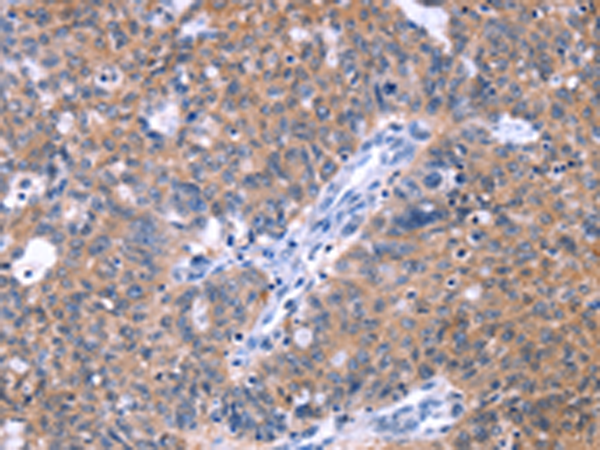
| WB | 咨询技术 | Human,Mouse,Rat |
| IF | 咨询技术 | Human,Mouse,Rat |
| IHC | 1/50-1/200 | Human,Mouse,Rat |
| ICC | 技术咨询 | Human,Mouse,Rat |
| FCM | 咨询技术 | Human,Mouse,Rat |
| Elisa | 1/2000-1/5000 | Human,Mouse,Rat |
| Aliases | PBF; PRF1; HDBP2; PRF-1; HDBP-2; HDRF-2; Si-1-8-14 |
| Host/Isotype | Rabbit IgG |
| Antibody Type | Primary antibody |
| Storage | Store at 4°C short term. Aliquot and store at -20°C long term. Avoid freeze/thaw cycles. |
| Species Reactivity | Human |
| Immunogen | Synthetic peptide of human ZNF395 |
| Formulation | Purified antibody in PBS with 0.05% sodium azide and 50% glycerol. |
+ +
以下是关于ZNF395抗体的3篇参考文献,按文献名称、作者及摘要内容简要概括:
---
1. **文献名称**:*ZNF395 regulates HIF-1α/VEGF signaling-driven tumor progression*
**作者**:Müller S, et al.
**摘要**:本研究利用ZNF395抗体通过免疫组化及Western blot技术,揭示了ZNF395在缺氧条件下通过调控HIF-1α/VEGF通路促进肿瘤血管生成和转移的机制,提示其作为癌症治疗靶点的潜力。
---
2. **文献名称**:*Antibody-based profiling of ZNF395 in stress-induced transcriptional networks*
**作者**:Tanaka K, et al.
**摘要**:通过ZNF395抗体进行染色质免疫沉淀(ChIP-seq)和蛋白质相互作用分析,发现ZNF395在氧化应激中调控下游靶基因(如ATF3)的转录,参与细胞应激适应和凋亡抵抗。
---
3. **文献名称**:*ZNF395 expression in skeletal muscle regeneration: A biomarker study*
**作者**:Garcia-Ruiz C, et al.
**摘要**:使用ZNF395抗体对肌肉损伤模型中的组织样本进行免疫荧光分析,证实ZNF395在肌肉再生过程中高表达,并通过调控肌源性分化基因(如MyoD)促进卫星细胞激活。
---
如需具体DOI或补充文献,可进一步扩展检索范围。
The ZNF395 antibody is a tool used to detect the zinc finger protein 395 (ZNF395), a transcription factor encoded by the *ZNF395* gene located on human chromosome 19. ZNF395 belongs to the zinc finger protein family, characterized by conserved C2H2-type zinc finger domains that mediate DNA or RNA binding. This protein is implicated in cellular stress responses, including hypoxia and inflammation, and has been linked to cancer progression, neurodegenerative disorders, and metabolic regulation. Studies suggest ZNF395 interacts with hypoxia-inducible factor 1 (HIF-1) pathways and modulates gene expression under low-oxygen conditions. It is also associated with tumorigenesis in hepatocellular carcinoma, osteosarcoma, and glioblastoma, acting as either an oncogene or tumor suppressor depending on context.
ZNF395 antibodies are typically generated in rabbits or mice using recombinant protein immunogens. They are widely used in techniques like Western blotting, immunohistochemistry, and immunoprecipitation to study ZNF395's expression, localization, and interactions. Commercial antibodies often target specific epitopes within its N-terminal or zinc finger regions. Researchers utilize these antibodies to explore ZNF395's role in diseases, its regulation under stress, and potential therapeutic targets. However, variability in antibody specificity and batch consistency remains a challenge. Validated ZNF395 antibodies are critical for elucidating its dual roles in cancer and neurodegeneration, as well as its diagnostic or prognostic utility.
×